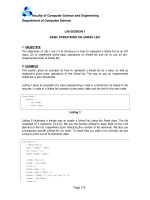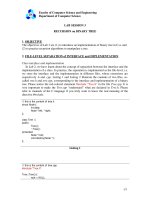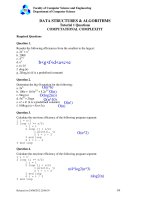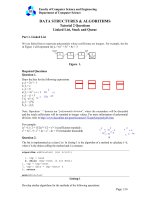NS2 Tutorial Kameswari Chebrolu Dept. of Computer Science and Engineering, IIT Bombay pdf
Bạn đang xem bản rút gọn của tài liệu. Xem và tải ngay bản đầy đủ của tài liệu tại đây (1.25 MB, 19 trang )
NS-2 Tutorial
Kameswari Chebrolu
Dept. of Computer Science and Engineering,
IIT Bombay
Motivation for Simulations
●
Cheap does not require costly equipment
●
Complex scenarios can be easily tested
●
Results can be quickly obtained – more ideas can
be tested in a smaller timeframe
●
The real thing isn't yet available
●
Controlled experimental conditions
–
Repeatability helps aid debugging
●
Disadvantages: Real systems too complex to
model
Features of NS-2
●
Protocols: TCP, UDP, HTTP, Routing algorithms,
MAC etc
●
Traffic Models: CBR, VBR, Web etc
●
Error Models: Uniform, bursty etc
●
Misc: Radio propagation, Mobility models , Energy
Models
●
Topology Generation tools
●
Visualization tools (NAM), Tracing
NS Structure
●
NS is an object oriented discrete-event simulator
–
Simulator maintains list of events and executes one event after
another
–
Single thread of control: no locking or race conditions
●
Back end is C++ event scheduler
–
Protocols mostly
–
Fast to run, more control
●
Front end is oTCL
–
Creating scenarios, extensions to C++ protocols
–
fast to write and change
TCL tutorial
●
Variables:
●
Arrays:
●
Printing:
●
Arithmetic Expression:
●
Control Structures:
●
Procedures:
set x 1
set y $x
set a(0) 1
puts “$a(0) \n”
set z = [expr $y + 5]
if {$z == 6} then { puts “Correct!”}
for {set i =0} {$i < 5} {incr i }{
puts “$i * $i equals [expr $i * $i]”
}
proc sum {a b} {
return [expr $a + $b]
}
NS programming Structure
●
Create the event scheduler
●
Turn on tracing
●
Create network topology
●
Create transport connections
●
Generate traffic
●
Insert errors
Creating Event Scheduler
●
Create event scheduler: set ns [new simulator]
●
Schedule an event: $ns at <time> <event>
–
event is any legitimate ns/tcl function
●
Start Scheduler
$ns at 5.0 “finish”
$ns run
proc finish {} {
global ns nf
close $nf
exec nam out.nam &
exit 0
}
Tracing
●
All packet trace
●
Variable trace
$ns trace-all [open out.tr w]
<event> <time> <from> <to> <pkt> <size>
<flowid> <src> <dst> <seqno> <aseqno>
+ 0.51 0 1 cbr 500 0 0.0 1.0 0 2
- 0.51 0 1 cbr 500 0 0.0 1.0 0 2
r 0.514 0 1 cbr 500 0 0.0 1.0 0 0
set par [open output/param.tr w]
$tcp attach $par
$tcp trace cwnd_
$tcp trace maxseq_
$tcp trace rtt_
Tracing and Animation
●
Network Animator
set nf [open out.nam w]
$ns namtrace-all $nf
proc finish {} {
global ns nf
close $nf
exec nam out.nam &
exit 0
}
Creating topology
●
Two nodes connected by a link
●
Creating nodes
●
Creating link between nodes
–
$ns <link_type> $n0 $n1 <bandwidth> <delay>
<queue-type>
set n0 [$ns node]
set n1 [$ns node]
$ns duplex-link $n0 $n1 1Mb 10ms DropTail
Sending data
●
Create UDP agent
●
Create CBR traffic source for feeding into UDP agent
●
Create traffic sink
set udp0 [new Agent/UDP]
$ns attach-agent $n0 $udp0
set cbr0 [new Application/Traffic/CBR]
$cbr0 set packetSize_ 500
$cbr0 set interval_ 0.005
$cbr0 attach-agent $udp0
set null0 [new Agent/Null]
$ns attach-agent $n1 $null0
Sending data
●
Connect two agents
●
Start and stop of data
$ns connect $udp0 $null0
$ns at 0.5 “$cbr0 start”
$ns at 4.5 “$cbr0 stop”
Creating TCP Connections
●
Create TCP agent and attach it to the node
●
Create a Null Agent and attach it to the node
●
Connect the agents
set tcp0 [new Agent/TCP]
$ns attach-agent $n0 $tcp0
set null0 [new Agent/TCPSink]
$ns attach-agent $n1 $null0
$ns connect $tcp0 $null0
Traffic on top of TCP
●
FTP
●
Telnet
set ftp [new Application/FTP]
$ftp attach-agent $tcp0
set telnet [new Application/Telnet]
$telnet attach-agent $tcp0
Introducing Errors
●
Creating Error Module
●
Inserting Error Module
set err [new ErrorModel]
$err unit pkt_
$err set rate_ 0.01
$err ranvar [new RandomVariable/Uniform]
$err drop-target [new Agent/Null]
$ns lossmodel $err $n0 $n1
Examples
●
UDP Script
●
Tracing (wired,wireless,tcp)
●
TCP without Loss
●
TCP with Loss
NS Internals
0
1
n0 n1
Addr
Classifier
Port
Classifier
entry_
0
Agent/TCP
Addr
Classifier
Port
Classifier
entry_
1
0
Link n0-n1
Link n1-n0
0
Agent/TCPSink
dst_=1.0
dst_=0.0
Application/FTP
Summary
●
Simulators help in easy verification of protocols
in less time, money
●
NS offers support for simulating a variety of
protocol suites and scenarios
●
Front end is oTCL, back end is C++
●
NS is an on-going effort of research and
development
Reference Material
●
/>●
Marc Greis' tutorial
●
Jae Chung tutorial
●
Ns manual









